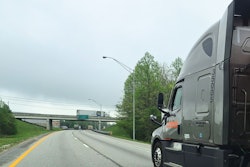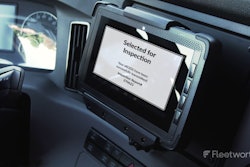The American Trucking Associations is calling on Transportation Secretary Mary Peters to push for a stay of a federal appeals court ruling on hours-of-service regulations and to encourage the Federal Motor Carrier Safety Administration to conduct an expedited rulemaking to address the court’s concerns.
An alternative to a stay is for the court to remand the rules, meaning that FMCSA would have to reconsider the two provisions the court objects to while those provisions remain in place, ATA says.
“While ATA is disappointed with the decision, we are encouraged by the fact that the shortcomings identified by the Court are procedural in nature and can be readily addressed by FMCSA,” ATA President Bill Graves said in a July 31 letter to Peters.
Citing procedural flaws in the rulemaking, the U.S. Court of Appeals for the District of Columbia Circuit on July 24 vacated the 11-hour driving time provision and the 34-hour weekly restart provision of the HOS regulations. With a 45-day period for FMCSA to seek reconsideration and another week for the ruling to take effect, the current regulations would remain in place at least until mid-September.
“There is no compelling safety reason for these two elements of the rule to be vacated,” Graves told Peters. “Just a week ago your Department issued its final truck-involved fatality figures for 2006 – the first full year of the industry operating under these new HOS rules – and fatalities declined by 4.7 percent, the largest drop in 14 years.”

In its reference to the “first full year,” ATA is talking about the rule as modified in August 2005. That modification sharply limited use of the sleeper berth for splitting rest. However, truck-involved fatalities in 2004 and 2005 – both full years operating under the first rewrite of the HOS rules – were higher than they were in 2003.
Graves told Peters that if the 11 hours of driving and the 34-hour restart are vacated in mid-September, “there will be disruptions in the supply chain, our economy will suffer, and the highway safety implications become an unreasoned variable.”
In asking for an expedited rulemaking on just those two provisions, Graves said that FMCSA’s policy decisions were sound and that FMCSA’s methodology just “needs to be better explained.”
At a news conference addressing ATA’s proposed national clearinghouse on drug testing results as well as the HOS situation, Graves said ATA would be filing its own motion for a stay but the support of DOT and FMCSA will be critical.
– Avery Vise
ATA Proposes Drug Testing Clearinghouse
The American Trucking Associations in August urged Congress to authorize and fund a centralized clearinghouse for positive drug and alcohol testing results of commercial motor vehicle drivers to ensure that motor carrier employers are aware of previous positive test results during the hiring process.
Speaking at the National Press Club in Washington, D.C., ATA President Bill Graves said such a clearinghouse would improve the industry’s ability to keep alcohol and drug abusers off the road and improve safety on the nation’s roadways.
The federal government required drug and alcohol testing of commercial truck drivers in 1995. As measured by a percentage of positive test results, drug abuse in the trucking industry is less than half of that found in the general work force, ATA says. But with between 2 percent and 2.5 percent of the truck driver population testing positive, that’s 68,000 drivers with some type of substance abuse problem, Graves noted, an unacceptable number.
A centralized clearinghouse would eliminate a significant loophole in the current drug and alcohol testing regulations, Graves said. Currently, employers must maintain records of positive tests for three years and provide the information to future prospective employers upon request. But if a driver who tested positive at that employer applies for a job at another carrier and leaves that employer off its job application, the prospective employer may not be aware of the positive drug test.
“It’s something we think is just good common sense,” Graves said of the clearinghouse.
ATA has lobbied for a clearinghouse since the 1990s. In 2004 the Federal Motor Carrier Safety Administration reported to Congress on the merits of reporting positive test results to states. Currently, five states have instituted a drug and alcohol clearinghouse.
“ATA and its members believe that state-based reporting efforts are a good first step, but the optimal solution is a national clearinghouse,” Graves said. “The trucking industry is a national industry. State-by-state action will result in a patchwork quilt of differing reporting requirements by different people, with different commercial driver licensing actions or outcomes for truck drivers depending upon which state issued their license. A national solution is the optimal approach to addressing this issue.”
Draft model legislation now is being circulated to the appropriate committees in the House and Senate, said Graves. Under the proposed legislations, drivers would have the right to view information on them that resides in the database and to appeal that data.
– Avery Vise and Todd Dills
Mexico States Its Own Cross-Border Rules
Mexican officials have listed their requirements for American carriers wanting to do business in Mexico.
Mexico’s requirements for American carriers that seek to operate beyond the border commercial zone are similar to U.S. demands on Mexican carriers, agency officials said. They include inspections by Mexican officials of carrier facilities in the United States.
Mexico asks applicants to include:
- Information on their registered agent in Mexico that represents the company.
- Data on drivers and training.
- Truck VIN numbers and other vehicle information.
- Length of operation and other information on file with the U.S. Department of Transportation.
Mexico’s pre-authority safety audit is similar to the American audit, and Mexico uses the same Commercial Vehicle Safety Alliance criteria for trucks, the FMCSA said.
The FMCSA does not track the number of American carriers that have applied for operating authority in Mexico. However, 34 Mexican carriers that have applied to do business in the United States have passed safety audits, while nine have failed and 47 have withdrawn, the FMCSA said.
Why so many have withdrawn is unclear, but some could have applied as far back as 2002, and their situation could have changed since then, the agency said.
– Jill Dunn
Paccar Breaks Ground on U.S. Engine Plant
Paccar Inc., parent company of Kenworth and Peterbilt, broke ground July 17 on its first engine plant in North America, to be located just west of Columbus, Miss.
The 400,000-square-foot facility, scheduled to be completed in 2009, will build Paccar’s planned Class 8 truck engine for on-highway and vocational applications.
For some of their medium-duty offerings, Kenworth and Peterbilt already offer only Paccar-badged engines, which are built by Cummins. But in Class 8, the truck brands will continue to offer customers a choice of engines, Paccar officials say. Today, Caterpillar and Cummins supply engines to Paccar in North America.
“This factory sends a strong signal of the strength of manufacturing in America,” said Mark Pigott, Paccar chairman and chief executive officer, at a groundbreaking ceremony that included Mississippi Gov. Haley Barbour and other dignitaries.
At a news conference after the groundbreaking, Jim Cardillo, Paccar executive vice president, noted that although Paccar will be new to the engine business in North America, “We have a long tradition of being a leader in the engine market in Europe.”
Paccar’s Columbus plant will build 12.9-liter and 9.2-liter diesel engines based on European platforms of the same displacement. Both European engines were on display at the groundbreaking ceremony. The 9.2-liter Paccar PR engine, which would be used mostly for vocational or LTL applications in North America, offers 250 to 360 horsepower and peak torque of 775 to 1,060 lbs.-ft. and weighs 1,860 lbs. The over-the-road 12.9-liter Paccar MX offers 360 to 510 horsepower and 1,310 to 1,850 lbs.-ft. of peak torque; that engine weighs 2,510 lbs.
The North American specs should generally be in the same range, although the upper end of horsepower on the 12.9-liter engine likely will be a bit lower, Craig Brewster, Paccar assistant vice president, told CCJ magazine. Brewster leads the engineering team for the new engines.
– Avery Vise
XM, Sirius Detail New Price Plan
Satellite-radio networks Sirius and XM announced details of their post-merger pricing plan July 23, a day before submitting it to the Federal Communications Commission. The plan allows customized pricing, which the FCC supports for cable television, but customers would need new radios to take full advantage of the change.
The companies announced in February their plans to merge, but the FCC and the antitrust division of the U.S. Department of Justice must approve before the merger can proceed.
The companies announced two main “a la carte” pricing options for the merged networks. One option will allow subscribers to choose 50 channels for $6.99 a month, compared to the current 100-channel subscription rate of $12.95, with additional channels available for a minimum of 25 cents a month. Under that plan, however, Sirius customers will be able to choose among only Sirius channels, XM customers among only XM channels.
The second option will allow subscribers to choose 100 channels from either network for $14.99 a month, compared to the current $25.90 cost of subscribing to both.
To take advantage of customized pricing, however, subscribers will need new, customizable satellite radios, the companies said. Neither the new sets nor the new programming options will be available immediately upon merger, though they should be available within a year of the merger, the companies said.
Subscribers to the merged service also will be able to pick a “family-friendly” tier of channels for $1 off the monthly rate, the companies said.
Subscribers who just want to keep the channels they have can do so for $12.95 per month, while new subscribers can opt for Sirius Everything and XM Everything packages at the same rate, the companies said.
– Kristie Busam
For more information, visit www.siriusmerger.com or www.xmmerger.com.
FYI | News Briefs
Fatality Rate Hits Low Mark
The number of people who died on the nation’s roads fell last year, the lowest highway fatality rate ever recorded, 1.42 per 100 million vehicle miles traveled. People who died in traffic crashes in 2006 were 42,642, or 868 less than in 2005. The 2-percent decline was the largest drop in 15 years. Fatalities of large-truck occupants saw little change, with 804 in 2005 compared to 805 in 2006. Deaths of other people involved in large-truck accidents, however, decreased by 5.5 percent, from 4,436 in 2005 to 4,190 in 2006. Total deaths involving large trucks decreased by 245, from 5,240 in 2005 to 4,995 in 2006, a 4.7-percent decline.
Survey Shows Poor Driver Health
Professional Driver’s Medical Depots recently completed a health survey of 2,000 drivers that shows nearly 65 percent of truck drivers rate their health as fair or poor – with 85 percent citing their top concerns as heart disease or diabetes. Ninety percent of drivers already take blood pressure, diabetes, cholesterol or heart medications. Additionally, 70 percent of drivers are at high risk for sleep apnea. Preliminary results from PDMD’s sleep survey indicate that the average weight of a driver is 240 pounds. PDMD opened its first facility in Knoxville, Tenn., in January and it plans to open 60 to 80 more centers by 2010.
Con-way to Buy CFI
Con-way Inc. announced July 16 that it would buy Contract Freighters Inc., a private North American truckload carrier based in Joplin, Mo., in a transaction valued at $750 million. Founded in 1951, CFI controls 2,600 tractors and 7,000 trailers and has 3,000 employees, 2,500 of them drivers. In 2006, CFI revenues were $427 million. CFI will join the Con-way Truckload division, which has 470 drivers, to create a truckload unit with more than $500 million in annual revenues, the companies say.
World’s Largest Truck Convoy
This year’s World’s Largest Truck Convoy, an annual fund-raiser for Special Olympics, is Sept. 15. The 2006 event raised nearly $550,000. Since it began in 2001, more than 5,000 trucks have traveled more than 1,000 miles during the Guinness Book of World Records event, which takes place at dozens of locations across North America. For locations and registration information, visit www.worldslargesttruckconvoy.com.
Bozo Hosts Truck Show
Dale Sommers, host of XM Satellite Radio’s “Truckin’ Bozo,” has announced the first Truckin’ Bozo’s Southeast Truck Show, Sept. 27-29 in Shreveport, La. The show will feature a number of free concerts, including one by the country singer Gene Watson, whose classic hits include “Love in the Hot Afternoon,” “Farewell Party,” and “Fourteen Carat Mind.” The show will be at the Louisiana State Fairgrounds, on I-20 at exits 13 and 16A. Tickets are $5 for adults, but CDL holders will be admitted free of charge. For more information, visit www.bozotruckshow.com.
No More Ramp Parking
Truckers are barred from parking on highways and interstates in Arkansas, including exit and entrance ramps. The Legislature passed HB 2431 in March, to take effect in July, but the law does not list penalties for violations. Research on truck parking in Arkansas was presented at the national meeting of the Transportation Research Board in January. Supply of parking at Arkansas truckstops and rest areas have not kept pace with demand, and truckers are forced to park illegally because of the lack of legal parking, the board was told.
New TA Opens in Laredo
TravelCenters of America has opened its 234th travel center, located on 30 acres adjacent to Interstate 35 in Laredo, Texas. The Laredo TA is accessed by northbound drivers on I-35 at Exit 11, Beltway Parkway and by southbound drivers on I-35 at Exit 13, Beltway Parkway.










